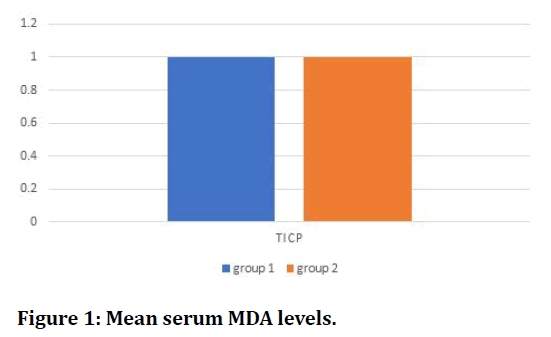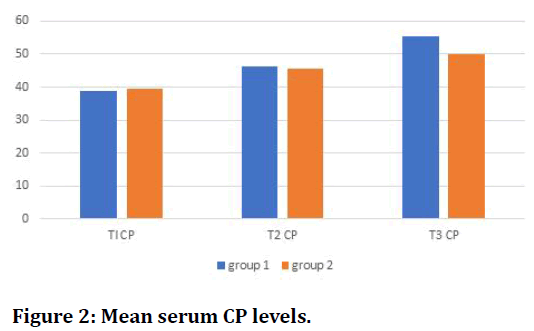Research - (2021) Volume 9, Issue 8
Oxidative Stress in Gestational Diabetes
*Correspondence: B Jaya, Department of Physiology, Sree Balaji Medical College & Hospital Affiliated to Bharath Institute of Higher Education and Research, India, Email:
Abstract
In this the present study the serum levels of oxidant¬ Malondialdehyde and antioxidant- Ceruloplasmin are compared between the different trimesters of pregnancy in both groups - The mean serum MDA levels in the total study group are l .64nmol/ml in the first trimester. The mean serum MDA level of group1 is l .63nmol/ml and of group II is 1.71 nmol/ml showing that there is no significant difference between the groups in the first trimester. In the second trimester the mean MDA levels in the uncomplicated antenatal subjects (group 1) increased to 2.89nmol/ml compared to the first trimester levels with a p value <0.05 which IS significant. In the second trimester the mean serum level of MDA 1n the GDM (group 2) subjects are 4.17nmol/ml which 1s significantly increased compared to their first trimester level with a p value< 0.01). Comparison of group 1 and group 2 MDA levels shows a p value <0.05 which is statistically significant increase in group 2 subjects. This may be due to increased oxidative stress prevalent in GDM causing an increase in oxidant MDA levels. In the third trimester, the was also similar result and an insignificant decrease 1n mean Cp levels in GDM subjects when compared to uncomplicated pregnant subjects in the second trimester. The results also shows .There is no significant association between MDA and Cp in the three trimesters of group I subjects.
https://sporbahisleri.livejournal.com https://wakelet.com/@SporBahisleri67459 https://theomnibuzz.com/author/sporbahisleri/ https://lessons.drawspace.com/profile/322207/sporbahisleri/workflow https://writeupcafe.com/profile/sporbahisleri/ http://www.pearltrees.com/sporbahisleri https://pharmahub.org/members/26874/blog https://www.zupyak.com/u/Spor-Bahisleri/ https://www.metroflog.co/sporbahisleri https://www.fuzia.com/fz/spor-bahisleri https://tr.pinterest.com/sporbahislerim/ https://my.getjealous.com/sporbahisleri https://sporbahisleri.contently.com https://hubpages.com/@sporbahisleri https://www.tumblr.com/sporbahisleri https://hub.docker.com/u/sporbahislerim https://betsiteleri.blogfree.net https://betsiteleri.amebaownd.com https://sporbahisleri.pixnet.net/blog https://betsiteleri.seesaa.net https://betsiteleri.threadless.com https://betsiteleri.neocities.org https://bahissiteleri.localinfo.jp https://betsiteleri.shopinfo.jp https://teletype.in/@betsiteleri https://ubl.xml.org/users/sporbahisleri https://betsiteleri.educatorpages.com https://betsiteleri.onlc.fr https://sporbahisleri.gumroad.com
Keywords
MDA, Timester, Ceruloplasmin.Introduction
Pregnancy induces progressive changes in maternal carbohydrate metabolism. The metabolic adaptations that occur during pregnancy are aimed to accommodate the rapidly increasing metabolic demand of the foetus.
Pregnancy induces the change in carbohydrate metabolism which is due to increased serum levels of estrogen and progesterone which induces beta cell hyperplasia resulting in hyperinsulinaemia and increased sensitivity to insulin resulting in net fasting blood glucose levels in the initial trimesters in the later stages the levels of placental lactogen, prolactin and cortisol are increased and hence body turns resistance to insulin and stress on carbohydrate metabolism which is eventually leading to gestational diabetics.
Reactive Oxygen Species (ROS) are free radicals that form as a natural by-product of normal metabolism of oxygen which is needed for defensive mechanism but excessive production of this may lead to tissue injury and cell death. Antioxidants that are present in tissues have the potential to neutralize these free radicals. Oxidative stress ensues when free radical overwhelm the antioxidant protective mechanism of cells and tissues. It induces cytotoxic effects that are mediated by perturbation of intracellular calcium and thiol homeostasis.
Oxidative stress causes induction of antioxidant enzyme activities and this causes increase in Superoxide dismutase activity. There is a progressive fall of activity of G1utathione peroxidase .The activities of Catalase and Glutathione reductase gradually decrease throughout the 3 trimesters of pregnancy. Some studies have shown there is a reduced Superoxide dismutase activity in the third trimester of normal pregnancy as compared to nonpregnant women·
Pregnancy exhibits increased susceptibility to oxidative stress leading to potential damage. But this is balanced by the adaptive response of the antioxidants in uncomplicated pregnancy.
When there is an imbalance between these antioxidants and free radicals, there creates oxidative stress. Hence this study aims to evaluate oxidative stress in gestational diabetes by estimating the levels of free radicals and antioxidant levels [1-5].
Methodology
Design of the study: Prospective cohort study.
Period of the study: July, 2010 to September, 2011. This prospective cohort study was approved by Institutional Ethical Committee. 180 female subjects attending the antenatal outpatient Department, Sree Balaji Medical College and Hospital, Chromepet were recruited for the study in the first trimester and followed up there after. Written informed consent was obtained from each person.
Each subject underwent routine history, examination and blood investigations. They were aged between 19 years and 35 years with similar nutritional habits and belonged to the same socioeconomic status. None of them had the habit of alcohol consumption or smoking.
Inclusion criteria
Subjects attending antenatal outpatient Department in the first trimester with history of present normal pregnancy and those with previous history of GDM were recruited.
The antenatal subjects who had normal glucose tolerance throughout pregnancy were designated as group 1. The antenatal subjects who developed gestational diabetes 1n second trimester were designated as group 2.
Exclusion criteria
Patients with history of hypertension, diabetes, asthma, and recent surgeries, pre-eclampsia or any other chronic ailments were excluded from the study. Major diseases which would alter oxidant and antioxidant levels were eliminated in the first trimester by doing Haemoglobin, ESR, Blood Sugar, LFT and Serum Creatinine.
Collection of blood samples
After obtaining written informed consent venous blood samples were collected from each of the subjects, in the morning in EDT A and plain tubes, in all the 3 trimesters (T1, T2 and T3) of pregnancy. Oral glucose tolerance test was done based on WHO recommendations, by taking blood samples, 2 hours after intake of 70 g of oral glucose. Patients of age group between 19 to 35 years were included in the study. Blood samples from all three trimesters were collected for the study. Serum Malondialdehyde (oxidants) and Ceruloplasmin (antioxidants) was estimated. Two groups were created for the study. Group 1 were individuals who were normal glucose tolerance throughout pregnancy and who had gestational diabetics were designated as group 2.
Statistical analysis
Data were expressed as mean ± SD (standard deviation). The significance of the results was assessed by the Student's t-test: A p value <0.05 was considered statistically significant. The correlation between the parameters was performed using Pearson correlation coefficient (r).
Results
The results revealed that there is no significant difference in mean serum MDA level between the two groups in the first trimester. The second trimester MDA level is significantly increased in group 2 subjects compared to group 1 with p value <0.05.
The third trimester MDA levels of group 2 are significantly higher compared to group 1 with p value <0.05 (Figure 1). In the second trimester there is an insignificant decrease in the mean serum Cp level of the group 2 subjects when compared with the group 1 subjects.

Figure 1. Mean serum MDA levels.
In the third trimester mean serum Cp level is significantly lower in the group 2 subjects compared to the group 1 with p value <0.05 (Figure 2).

Figure 2. Mean serum CP levels.
There is no significant difference in mean serum MDA level between the two groups in the first trimester. The second trimester MDA level is significantly increased in group 2 subjects compared to group 1 with p value <0.05. The third trimester MDA levels of group 2 is significantly higher compared to group 1 with p value <0.05 (Table 1).
| Group 1 n=153 | Group 2 n=27 | p | |
|---|---|---|---|
| Tl MDA nmol/ml | 1.63 ± 0.75 | 1.71 ± 0.61 | NS |
| T2 MDA nmol/ml | 2.89 ± 0.95 | 4.17 ± 1.69 | p<0.05 |
| T3 MDA nmol/ml | 2.57 ± 0.72 | 3.41 ± 0.84 | p<0.05 |
Table 1: Comparison of mean serum MDA levels between group 1 and group 2 subjects in the 3 trimesters.
There is no significant difference in mean serum Cp levels between the two groups in the first trimester.
In the second trimester there is an insignificant decrease in the mean serum Cp level of the group 2 subjects when compared with the group 1 subjects.
In the third trimester mean serum Cp level is significantly lower in the group 2 subjects compared to the group 1 with p value <0.05 (Table 2).
| Group 1 n=l53 | Group 2 n=27 | p | |
|---|---|---|---|
| T1 Cp mg/dl | 38.74 ± 4.17 | 39.58 ± 5.2 | NS |
| T2 Cp mg/dl | 46.26 ± 3.97 | 45.71 ± 4.42 | NS |
| T3 Cp mg/dl | 55.4 ± 4.92 | 49.87 ± 4.43 | p<0.05 |
| T1: First trimester, T2: Second trimester, T3: Third trimester | |||
Table 2: Comparison of mean serum Ceruloplasmin levels between group 1 and group 2 subjects in the 3 trimesters.
Discussion
In the present study the serum levels of oxidant Malondialdehyde and antioxidant- Ceruloplasmin are compared between the different trimesters of pregnancy in both groups -uncomplicated antenatal subjects with normal glucose tolerance (group 1) and those who developed gestational diabetes (group 2). Looking at the mean serum MDA is no significant difference between the groups in the first trimester. In the second trimester uncomplicated antenatal subjects (group 1) MDA levels increased to compare to the first trimester levels. Previous studies shown significant increase in MDA levels in gestational diabetes subjects compared to uncomplicated pregnancies. In the second trimester in group 2 subjects the mean Cp levels increased to 45.71 mg/dl. Compared to the first trimester there is a significant increase in the mean Cp levels in second trimester with a p value <0.05 This is similar to studies by Cousins et al. The present study suggests GDM is associated with increased oxidative stress compared to normal pregnancy, as shown by the increased MDA levels. The Cp levels in second and third trimester of group 2 was altered significantly showing that there is an alteration in oxidant antioxidant balance in gestational diabetes [6-10].
Conclusion
The present study suggests GDM is associated with increased oxidative stress compared to normal pregnancy, as shown by the increased MDA levels in the second and third trimesters in group 2 Subjects. The Cp levels in second and third trimester of group 2 was altered significantly showing that there is an alteration in oxidant antioxidant balance in gestational diabetes.
References
- Carrapat MRG. The offspring of gestational diabetes. J Perinat Med 2003; 31:5-11.
- Thomas T, Schreiber G, Jaworowski A. Developmental patterns of gene expression of secreted proteins in brain and choroid plexus. Dev Biol 1989; 134:38-47.
- Guttridge JMC. Ceruloplasmin: A plasma protein, enzyme, antioxidant. Ann Clin Biochem 1978; 15:293-296.
- Reed DJ. Status of calcium and thiols in hepatocellular injury by oxidative stress. Semin Liver Dis 1990; 10:285-292.
- https://www.moscmm.org/pdf/Guyton%20physiology.pdf
- Chen X, Scholl TO. Oxidative stress: changes in pregnancy and with gestational diabetes mellitus. Current Diabetes Reports 2005; 5:282-8.
- Buettner GR. The pecking order of free radicals and antioxidants: lipid peroxidation, a-tocopherol, and ascorbate. Arch Biochem Biophysics 1993; 300:535-43.
- Dhalla NS, Elmoselhi AB, Hata T, et al. Status of myocardial antioxidants in ischemia–reperfusion injury. Cardiovascular Res 2000; 47:446-56.
- Sobki SH, Al-Senaidy AM, Al-Shammari TA, et al. Impact of gestational diabetes on lipid profiling and indices of oxidative stress in maternal and cord plasma. Saudi Med J 2004; 25:876-80.
- Yoshioka T, Motoyama H, Yamasaki F, et al. Lipid peroxidation and vitamin E Levels during pregnancy in rat Biol Neonate 1987; 52:223-231.
Author Info
Department of Physiology, Sree Balaji Medical College & Hospital Affiliated to Bharath Institute of Higher Education and Research, Chennai, Tamil Nadu, IndiaCitation: B Jaya, Oxidative Stress in Gestational Diabetes, J Res Med Dent Sci, 2021, 9(8): 84-86
Received: 14-Jul-2021 Accepted: 09-Aug-2021
